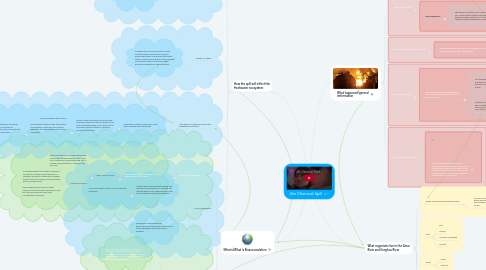
1. Effects/What is Bioaccumulation
1.1. What is bioaccumulation
1.1.1. Bioaccumulation is the absorption of chemicals into a food chain
1.1.1.1. When does it occur?
1.1.1.1.1. Bioaccumulation occurs when toxins enter a food chain through several means: they can be ingested, absorbed through skin or inhaled, and plants take in toxins directly from soil.
1.1.1.1.2. How does it work?
1.2. Effects of Bioaccummulation on Food Chain
1.2.1. As toxins are absorbed into the fat tissue of organisms and it goes up the food chain predators at the top of the food chain absorb the most of the toxins due to the amount of prey they are consuming.
1.2.2. This consumption of toxins can result in cancers
1.2.3. While bio accumulators are stored in fat, they are released into the bloodstream when an animal uses body fat for energy, harming vital organs and systems
2. How the spill will effect the freshwater ecosystem
2.1. Effects on sediment/bottom of the rivers
2.1.1. At the bottom of these rivers is mud and sediment that serve as homes to many worms, insects, and shellfish. Oil in sediments may be very harmful because sediment traps the oil and affects the organisms that live in or feed off the sediment
2.1.2. Rocks found in and around flowing water serve as homes for mosses, which are an important basic element in a freshwater habitat's food chain. Spilled oil can cover these rocks, killing the mosses and disrupting homes
2.2. Effects on banks
2.2.1. Oil spilled into most rivers often collects along the banks, where the oil clings to plants and grasses. The animals that ingest these contaminated plants are then effected and the toxin travels up the food chain hurting the predators in the ecosystem
2.3. How Bioaccumulation will effect the Freshwater ecosystem
2.3.1. Absorption of toxins to the lower food chain organisms like autotrophs
2.3.1.1. Moves up the food chain from autotrophs to heterotrophs the toxins are stored in the fat of the heterotrophs. As it travels up the food chain the top organism, predators, absorb the most toxin
2.3.1.1.1. Drop in predators due to toxin
2.3.1.1.2. With limited predators other species that the predators consumers will increase leading to an overpopulation issue in the ecosystem
2.4. Loss in biodiversity
2.4.1. A study was conducted that showed that because of the presence of benzene and nitrobenzene in river water resulted in the loss of diatom and mussel populations
2.4.1.1. Loss in population lead to a loss in potential speciation
2.4.2. As predators decrease due to bioaccumulation the species diversity and survival decrease due to the lack of numbers.
3. What happened/general imformation
3.1. Where did it occur?
3.1.1. The spill occured in Jilin City, China on November 13th, 2005
3.1.2. What happened?
3.1.2.1. The explosion resulted from a blockage in one of the nitration towers that was not handled properly resulting in 100 tons of chemicals being released into nearby water
3.1.2.1.1. What was spilled?
3.2. How the spill spread/how far it went
3.2.1. The spill spread by leaking into the Songhua river, it then ran into Jilin City then Russia affecting its city of Khabarovsk.
3.3. Government action
3.3.1. The Chinese Government neglected to inform the public about the crisis until 10 days after the spill.
3.3.1.1. This lag time of doing nothing to stop the pollutants resulted in the further spread of the toxins into the Amur River and into Russia
3.3.1.2. Eventually, the Government issued acts to help combat the pollution but it was very minimal and too late. They also denied help from other countries in their efforts.
3.4. Who was held responsible
3.4.1. The Chinese government held Jilin Petrochemical corporation responsible for the explosion however the impacts of the explosion should be given to the Chinese government for failing to do anything to help the clean up of the spill.
4. What organisms live in the Amur River and Songhua River
4.1. Where is the Amur and Songhua River?
4.1.1. The Amur River flows from China into Russia and have many offshoots such as the Songhua River that flows into the city of Jilin
4.2. FIsh
4.2.1. Pike
4.2.2. Catfish
4.2.3. Northern Snakehead
4.2.4. Mussels
4.3. Plants
4.3.1. Algea
4.3.2. Diatoms
4.4. Bugs
4.4.1. Water Bugs
4.5. Endangered Animals that depend on the Amur and Songhua River
4.5.1. Amur leopard (endangered)
4.5.2. Amur tiger (endangered)

